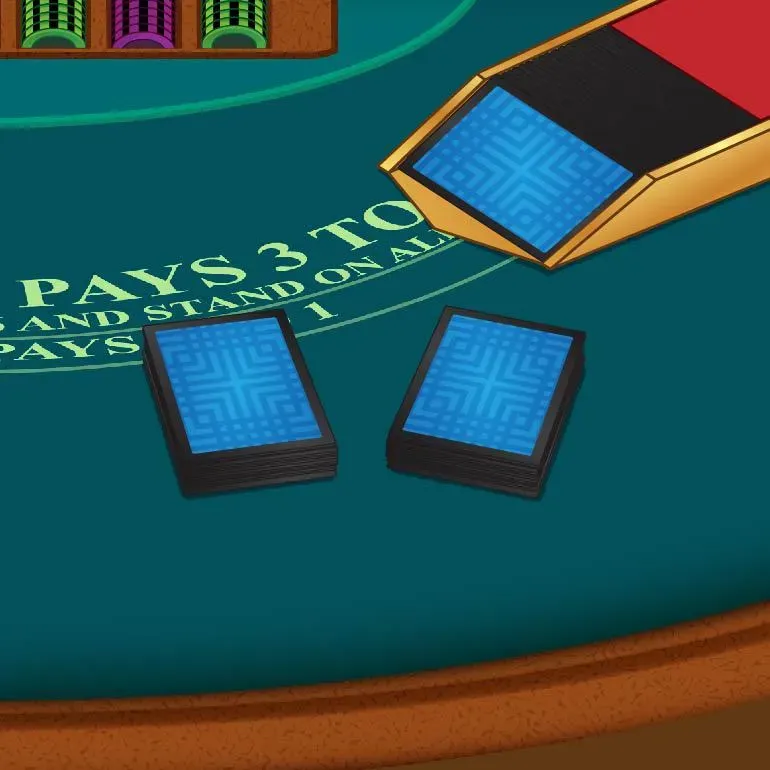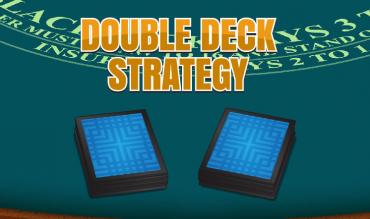TABLE OF CONTENTS
- Download Blackjack Strategy Chart for Double Deck Game
- Double-Deck Rules & Playing Strategy
- Double-Deck Card Counting
- Summary
One of the questions I often get from blackjack players is this: My favorite live casino just installed a double-deck blackjack game. What changes do I need to make to my playing and betting strategy compared to a six- or eight-deck game?
I’ve had a lot of experience playing all of the above games, but my favorites were the single- and double-deck games. Toward the end of my playing career, I stopped playing single-deck games when the casinos began shorting the payoff on blackjack hands (from 3-2 to 6-5). My main focus, thereafter, was double-deck games, and I’ll explain below what changes you need to make when switching from a six- or eight-deck game to a double-deck game (both for a basic blackjack strategy player and card counter).
DOUBLE-DECK RULES & PLAYING STRATEGY
I’ll assume that the six- or eight-deck game allows doubling after pair splitting (DAS) and surrender is not offered. I’ll cover the strategy changes for two scenarios: when the dealer must stand on soft 17 (S17) or hit soft 17 (H17).
If Playing Rules are S17 and DAS
The playing strategy changes that you should make when switching from a six- or eight-deck game to a double-deck game with the above rules are as follows.
• Double down hard 9 against a dealer deuce
• Double down hard 11 against a dealer ace.
• Split 6-6 against a dealer 7.
• Split 7-7 against a dealer 8.
If Double Deck Playing Rules are H17 and DAS
If the double-deck rules specify that the dealer must hit soft 17 (H17) rather than stand (S17), then you should include these three additional changes to the above S17 strategy.
• Double down A-3 (soft 14) against a dealer 4.
• Double down A-7 (soft 18) against a dealer deuce
• Double down A-8 (soft 19) against a dealer 6
You’ll be facing the lowest house edge by incorporating the above in your playing decisions and playing all your other hands accurately. (House edge is –0.18% for S17/DAS and –0.38% for H17/DAS.)
Tip: Before you jump in and start playing any double-deck game, make sure you check the blackjack rules and the payoff for a blackjack. For example, some casinos are paying only 6-5 for a blackjack (instead of 3-2). Others don’t allow doubling down after pair splitting. (These are horrible games that should be avoided.) Play only double-deck games where a blackjack is paid at 3-2, you can double down after pair splitting (DAS), and ideally, with S17. (If the playing rules specify H17, that’s acceptable, even though it is not as favorable as an S17 game.)

Note: For the complete basic playing strategy charts for a double-deck game with S17 and H17, see Chapter 3 of my free Ultimate Guide to Blackjack.
DOUBLE-DECK CARD COUNTING
Card counting in a double-deck game requires several changes to your betting strategy. The reason is there are two primary differences in counting a double-deck vs. a six-deck game:
• the true count tends to rise and fall more frequently, and
• you’ll be playing more hands where you have the edge.
Card counters have to be patient when they play, say, a six-deck game because it often takes several rounds after the shuffle before the count goes sufficiently positive, meaning the edge swings in their favor (and the counter will increase his bets). Sometimes the count will never get positive during the entire six-deck shoe. However, on the bright side, once the count goes positive it tends to stay positive for several rounds allowing the counter to fire away with big bets.
When you play a double-deck game, the true count is more volatile. It can quickly go positive after a round or two but just as quickly fall into negative territory. You’ll also be playing more hands where you have the edge so you don’t need as big a bet spread as you would for a six-deck game. (This is why card counters need a bigger bet spread in a six- or eight-deck game; they need to bet a lot more when they have the edge to compensate for the more frequent hands they play where they don’t have the edge.) For example, you’ll need a 1‒10 or 1‒12 bet spread to get a respectable edge in a six-deck game; however, for a double-deck game, a 1‒6 or 1‒8 spread often will suffice.
Penetration, or the percentage of cards dealt until the shuffle, is very important in double-deck games. Many casinos instruct their live dealers to place the cut card at 50%, meaning that, after one deck is played, the decks are shuffled. A double-deck game with 50% penetration is less profitable for a card counter then a similar game with 60% to 75% penetration (1.2 to 1.5 decks played). Therefore, if you are a card counter, you need to be sure the penetration is greater than 50%.
Here’s another tip I used that can come in handy when you are counting a double-deck game. Because there are only 104 cards in a double-deck game, just a few extra cards that are put into play before the cards are shuffled can significantly increase your advantage. Therefore, if the count is positive and you know that the next round will be the last one before the shuffle, spread and play two (or three) spots. You’ll be playing more hands where you have the edge in the game while consuming more of the undealt cards, which results in deeper penetration (advantageous for the play of the additional hand or hands). (However, don’t use this ploy at the end of every positive deal, because it will attract too much attention from pit supervisors.)
SUMMARY
I played mostly double-deck games with good rules and deep penetration during my playing career. They were profitable for me but you must be discreet with your card counting and betting. (For details on camouflaging your card counting skills, see Chapter 10 in my Ultimate Guide to Blackjack.)
